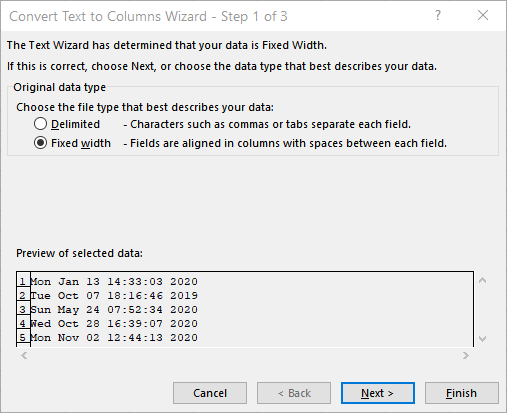Please Note: This article is written for users of the following Microsoft Excel versions: 2007, 2010, 2013, 2016, 2019, and 2021. If you are using an earlier version (Excel 2003 or earlier), this tip may not work for you. For a version of this tip written specifically for earlier versions of Excel, click here: Converting an Unsupported Date Format.
Written by Allen Wyatt (last updated April 24, 2021)
This tip applies to Excel 2007, 2010, 2013, 2016, 2019, and 2021
It is not uncommon to load information from other programs into Excel. For instance, you may have data generated by another program, and you want to analyze that data in Excel. When you import data into Excel, it does a fairly good job of assigning the proper data types to information, and it can even parse and convert some data.
When it comes to dates and times, however, not all programs speak in a way that Excel can understand. For instance, if your other program stores dates in the format "Mon Jan 13 14:33:03 2011", then Excel won't be able to parse the date and you will need to do the conversion in some other manner.
Fortunately, most programs generate their dates and times in a format that follows a pattern. Assuming, for instance, that "Mon Jan 13 14:33:03 2001" represents the format followed by all dates, you can do the conversion using a simple formula:
=DATEVALUE(MID(A1,9,2)&MID(A1,5,3)&RIGHT(A1,4)) + TIMEVALUE(MID(A1,12,8))
This formula assumes that the foreign date/time format is in cell A1. Simply format the result of the formula using one of Excel's date/time formats, and you'll have no problem.
If you prefer, you can use the Text to Columns function to break the foreign date/time format into its integral parts:

Figure 1. The Convert Text to Columns Wizard.
The dates and times are now separated into five individual columns. You can now use a formula to put a valid date/time back together. For instance, assuming that the exploded version of the date/time is in cells A1:E1, you could use the following:
=(C1&B1&E1)+D2
Again, format the result using a date/time format, and you are all set.
If you prefer to use a macro to do the conversion, then the following macro will step through all the selected cells and do the conversion:
Sub ConvDate()
Dim c As Range
For Each c In Selection.Cells
c = DateValue(Mid(c, 5, 6) & ", " _
& Mid(c, 21, 4)) + TimeValue(Mid(c, 12, 8))
c.NumberFormat = "dd MMMM yyyy h:mm:ss"
Next c
End Sub
The macro converts the text string to an acceptable date/time (using DateValue) and then formats the cell to display the value property.
Note:
ExcelTips is your source for cost-effective Microsoft Excel training. This tip (9779) applies to Microsoft Excel 2007, 2010, 2013, 2016, 2019, and 2021. You can find a version of this tip for the older menu interface of Excel here: Converting an Unsupported Date Format.

Solve Real Business Problems Master business modeling and analysis techniques with Excel and transform data into bottom-line results. This hands-on, scenario-focused guide shows you how to use the latest Excel tools to integrate data from multiple tables. Check out Microsoft Excel Data Analysis and Business Modeling today!
It can be handy to know when specific weekdays occur within a range of dates. Figuring out this information, using ...
Discover MoreDo you look forward to the weekend? Well, you can use Excel to let you know when the next weekend begins. Here's how you ...
Discover MoreNeed to figure out when a fiscal year ends when that period does not correspond to the calendar year? Here are some ways ...
Discover MoreFREE SERVICE: Get tips like this every week in ExcelTips, a free productivity newsletter. Enter your address and click "Subscribe."
2021-04-26 03:05:34
Mark Galloway
Shouldn't the formula "=(C1&B1&E1)+D2" be "=(C1&B1&E1)+D1" ?
Got a version of Excel that uses the ribbon interface (Excel 2007 or later)? This site is for you! If you use an earlier version of Excel, visit our ExcelTips site focusing on the menu interface.
FREE SERVICE: Get tips like this every week in ExcelTips, a free productivity newsletter. Enter your address and click "Subscribe."
Copyright © 2025 Sharon Parq Associates, Inc.
Comments